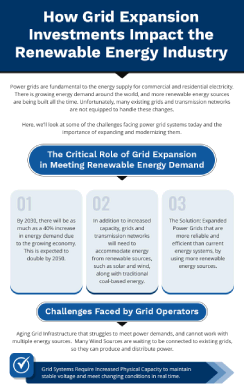The Role of Power Grid Expansion in Accelerating Renewable Energy Adoption
Posted by American Wire Group on | Comments Off on The Role of Power Grid Expansion in Accelerating Renewable Energy AdoptionPower grids are fundamental to the energy supply for commercial and residential electricity. There is growing energy demand around the world, and more renewable energy sources are being built all the time. Unfortunately, many existing grids and transmission networks are not equipped to handle these changes.
Here, we’ll look at some of the challenges facing power grid systems today and the importance of expanding and modernizing them.
The Critical Role of Grid Expansion in Meeting Renewable Energy Demand
It has been estimated that the combination of a growing economy and the push toward renewable energy will lead to as much as a 40% increase in energy demand by 2030, with demand expected to double by 2050. To facilitate this transition, energy systems will require expanded power grids that are more reliable and efficient than what is currently in operation.
In addition to increased capacity, grids and transmission networks will need to accommodate energy from renewable sources, such as solar and wind, along with traditional coal-based energy. This in turn drives further investment in renewable energy and makes it possible to store and deliver solar- and wind-generated electricity to remote areas.
Challenges Faced by Grid Operators
Aging grid infrastructure struggles to meet power demands and often lacks the flexibility to work with multiple energy sources. At this time, many North American-based wind projects are waiting to be connected to existing grids so the power they produce can be distributed and used.
To remedy this, grid systems need increased physical capacity to maintain stable voltage and reliable supply to meet demands and changing conditions in real-time.
Renewable energy sources are intermittent: photovoltaic (PV) cells cannot gather solar energy at night or on overcast days, and wind changes direction and intensity which impacts turbines. This means grid and transmission systems must be able to balance power from multiple sources to maintain a stable supply at all times. Integrating adequate storage solutions, such as battery energy storage systems (BESS), to hold an excess of generated energy for later distribution will also be critical to consistent energy supply.
Grid operators also need the ability to model grid and power transmission systems, including the potential effects of weather, climate, equipment failure, and supply and demand. This allows for data-driven decision-making in critical situations and for general infrastructure planning.
Investment Needs for Achieving Net-Zero Emissions
In the US, to accommodate current and future energy transition initiatives and meet growing demand, grid infrastructure development will be critical. It is estimated that grid investment needs to nearly double by 2030 to over USD $600 billion per year to meet climate goals.
Historically, the US’s investment in electrical grids has grown from $63 billion in 2016 to $89 billion in 2022. And since the 2021 passage of the Infrastructure Investment and Jobs Act (IIJA), an additional $13.3 billion has been made available for grid infrastructure improvements.
For the greatest return on investment and best odds of reaching net-zero emissions, grid investment has to be comprehensive, including:
- Grid hardware, cables, wires, and equipment
- Energy storage equipment, including battery systems
- Data management tools to estimate grid capacity and model the effect of energy demand
- Procedures and equipment to streamline and standardize connections to integrate renewables
- Secure supply chains
- Skilled workers for jobs on lines, grids, and construction as well as professionals with expertise in power engineering and planning
Benefits of Expanding Transmission Lines
Expanding transmission lines increases power distribution, bringing energy to remote areas efficiently. It also bolsters renewable energy integration by connecting more solar and wind farms with grids and storage. The more that renewable energy sources can be put to use, the more incentive there is to build them. Advantages of expanding transmission lines include:
- May reduce or level off power costs across larger geographic areas
- Upgrading and replacing aging or suboptimal wire and cable
- Broadening access to clean energy
- Faster ROI on renewable energy infrastructure
- Reduced risk of outages
AWG’s Role in Supporting Power Grid Expansions
American Wire Group specializes in solutions for utility and renewable energy sources. We are proud to support the power transmission & distribution, substation, solar, wind, BESS, and electric vehicle (EV) infrastructure industries.
Our experienced team can help you select the right solutions based on your needs. We carry the largest inventory of wires and cable, equipment, and hardware, and can deliver in days.
Take Action With AWG: Empowering the Future of Renewable Energy
AWG is here to support major grid expansions for the widespread adoption of renewable energy. You can count on us for comprehensive power grid equipment and services, including cable management, cable engineering and design, supply chain, emergency services, lifecycle management, and maintenance support.
Contact us to learn more!


